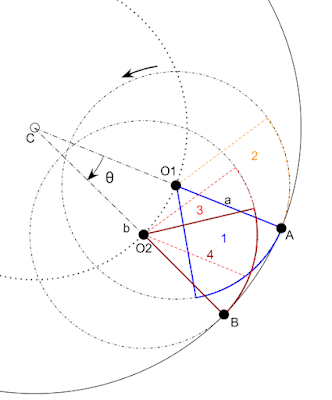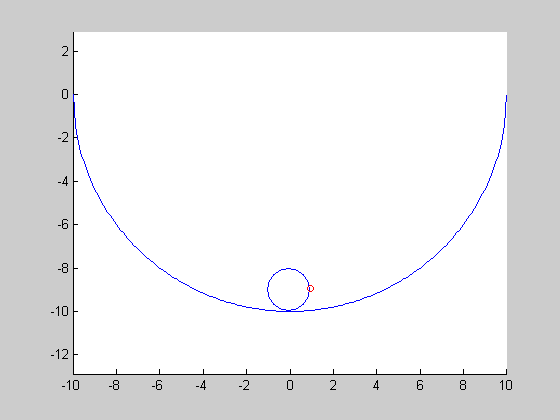Second example added!
This may help you understand why the coin actually rotates more than you expect.
It will be easier if you focus on a slice of left coin. Lets say 1 is the pizza slice that is to be rotated about the coin on right. If there is no friction at all, the left coin will just slip and slice 1 will end up at position 2. Now if the coin rolls without slipping, you may think because the contact point runs on a arc distance R*θ on the right coin, this arc distance should require slice 1 to rotate an θ angle (because left coin also has radius R). So we will expect slice 1 to translate to slice 2 and rotate θ and then end up at position 3. But we should get slice 4 position if slice 1 is to be rolled without slipping. What's wrong?!! The important thing here is when slice 1 rolls, not only does the contact point move on edge of slice 1, on top of that the center of slice 1 also rotates with respect to the contact point when the contact point moves!! ( and they are done in such a smooth fashion that one wouldn't notice! ). Take some time to get this here. Another word, during any instance of rolling, contact point is at rest (always), the center of left coin rotates a little bit about the contact point (, due to the fact that this coin actually rolls on a curve path!). It turns out the center point of slice 1 also rotates against the contact point by an angle θ during whole rolling motion. (This can be seen from the relative position of contact and center point before and after rolling.) So in total, the body (slice 1) actually rotates 2*θ!! This will make slice 2 rotate 2*θ and lead us to the slice 4 position!! So if the left coin rotates a full revolution against the right coin (θ=2π), the left coin actually rotates 4π (two revolutions!!).
Another illustration of the two rotations:
Rolling without slippage finite rotation consideration.
Deeper description:
It is worth to discuss the direction of the two angles described above, why do we add the two angles and not subtract them. Now imagine the right coin is just a flat line, so the left coin is rolling on a flat vertical line upward, without slippage. The contact point is still on the right hand side of the left coin, and the left coin has to rotate clockwise (abbreviated: c.) to go upward. So we have a c. rotation of the coin, if coin rolls on a flat surface. Now we put back the right coin and add in the curvature. Remember we said the center of left coin will rotate θ against the contact point clockwise during the whole rolling motion. And this is an additional rolling on top of the rotation coming from the coin rolling on a flat surface. What this actually infers is that CM also rotates
clockwise against the contact point of the left coin - notice this does not happen for coin rolling on a flat surface. Because rotation is a mutual and relative motion, CM rolls about the contact clockwise is just the same as contact rolls about the CM clockwise. And the later is a body rotation. So we can see the left coins rotate twice about its CM, both in the same direction (clockwise) by the same amount of angle θ. This is why we add two θ, not subtract θ from θ and get zero. The two θ rotations described above are actually the same in direction (an important concept). I will show in the next example when rolling on negative curves these two angles can cancel.
[A deeper thinking here is CM actually travels faster than that of the contact point, and that is why the coin rotate c.]
[Thinking: The contact point moves on the left coin counter-clockwise (c.c.). This means the left coin has to rotate clockwise, because the contact point should be at rest in our case.]
Example 2: Roll without slipping on negative curves.
 |
| A coin O1 rolls counter-clockwise (c.c) without slippage inside a circle C to a position O2. |
Second example. A coin centered on O1 rotates without slippage on a negative curvature centered at point C. The coin rotates to a position centered at O2. Again we will focus on a slice on O1 which will make things easier. Look at slice 1 of O1. The coin has a radius
a and the curvature has a radius
b. Let say the contact point travels from point A to point B on the curvature. During this rolling without slipping motion the contact point travels a distance on the coin equal to the arc length AB, which is b*θ. The coin has to rotate counterclockwise (c.c.) in order for the contact point to travel from A to B (to see this just imagine if the curve is flat). And because the contact point travels an arc length AB the amount of rotation translates to the coin will then be equal to bθ/a (larger than θ because b is greater than a). And this is a c.c. rotation. Just like our previous example, let's rotate slice 1 by bθ/a to get slice 2, and then translate slice 2 to slice 3 where the center of coin should end up at, O2. Hmm something is not right, if slice 1 is to roll without slippage shouldn't we get slice 4?!! So lets consider the other rotation. Whenever the velocity of center of mass mismatches that of the contact point, one will expect this extra turning of object (which happens for objects rolling on curvatures). Here the CM of the coin travels slower than the contact point, which means the CM will have a smooth rotation against the contact point at every instance in the clockwise direction. Because rotation is a mutual concept, CM rotates against the rested contact point in clockwise direction also means the object rotates about the CM in a clockwise direction. The amplitude of rotation can be seen from the relative positions of the center of coin and the contact point before and after the whole rolling motion: the angle changes of vector A-O1 to vector B-O2. Apparently this amount of angle change is θ. And the direction of this rotation is c.. So we have to rotate slice 3 by an angle θ in clockwise direction. This way we get slice 4. Voila!
To get the amplitude of the true rotation of the coin after this rolling without slipping lets add the two rotations together considering their direction of rotation: first we have bθ/a (c.c.) + θ (c.) = bθ/a (c.c.)
- θ (c.c.) = θ (b/a - 1) (c.c.). The result is the coin rotates counterclockwise by θ (b/a - 1)
with respect to the center of mass.
Below is a simulation I wrote with MATLAB for a sphere to roll inside a bowl without slipping, with gravity taken into account. The original codes can be found in another
post. The small red circle is a fixed point on the coin, to illustrate the rolling without slippage motion.
 |
| Here is a small animation I made using Matlab. |
Next I will explain the forces which cause those extra turnings. It is obvious the friction force causes the coin to rotate while the contact point travels. But for the second half, what forces cause the CM to rotate against the contact point? They are actually the external forces which make the object to stay on the curves! For example in the first case it is 'you' forcing the two coins to stay together. In order to make them stick and slide without slipping, you finger does the extra turning of the coin! In the second example your finger prohibited the further rotation. This will need some more graphs to illustrate. To be continued...








